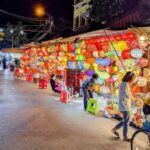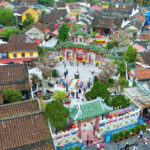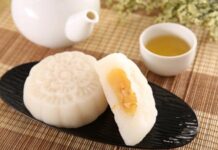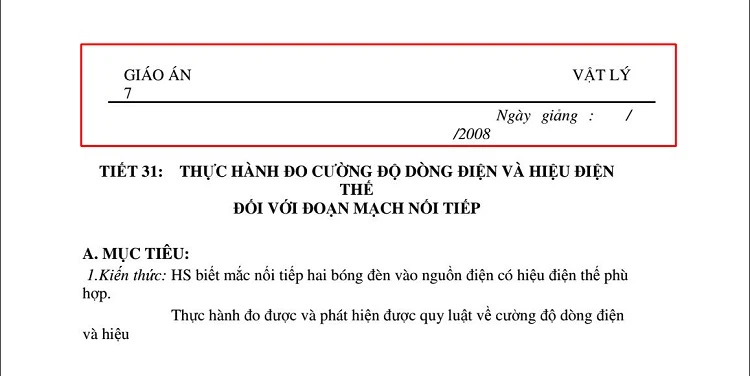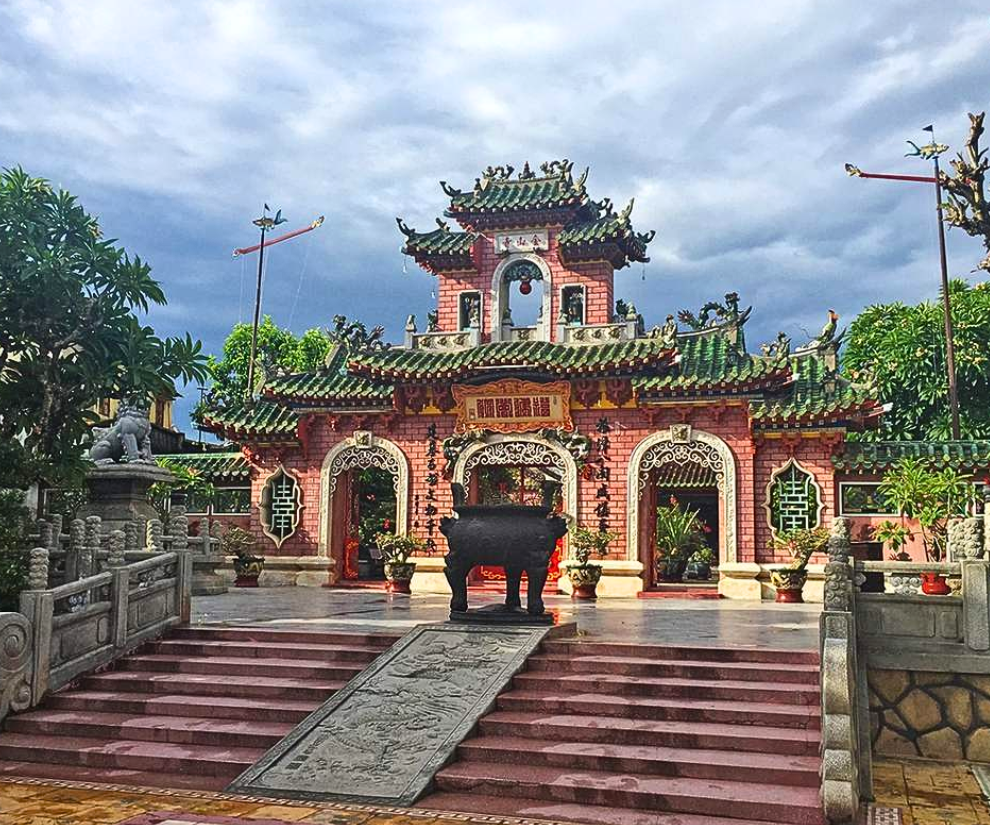
Not only does it captivate visitors with its opulent beauty, but it also serves as a repository of the profound spiritual values of the Chinese community that once resided and had a strong bond with this land for centuries.
Fukien Assembly Hall – A Witness to a Prosperous Trading Era
Hoi An used to be a thriving international port in the 16th and 17th centuries, welcoming trading vessels from China, Japan, India, and Europe. Among the diverse communities that settled here, the Chinese, particularly the Fukienese, made this place their long-term home. To maintain community bonds, worship their ancestors, and exchange cultural traditions, they established assembly halls, which served as both cultural centers and spiritual anchors for the expatriate Chinese population.
Constructed in 1697, the Fukien Assembly Hall initially served as a small temple dedicated to Thien Hau Holy Mother, the goddess who protects fishermen and sailors. Over time, with the collective efforts and contributions of the community, the temple underwent renovations and expansions, transforming into the grand and vibrant assembly hall we see today. This transformation reflects the prosperity and devotion of the Fukienese community to their revered deities and ancestral roots.
The Fukien Assembly Hall impresses visitors with its architecture, which is heavily influenced by classical Chinese styles. The three-entrance gate, painted in red and gilded with intricate dragon and phoenix motifs, along with distinctive ceramic decorations, stands out among the ancient town’s subdued color palette.
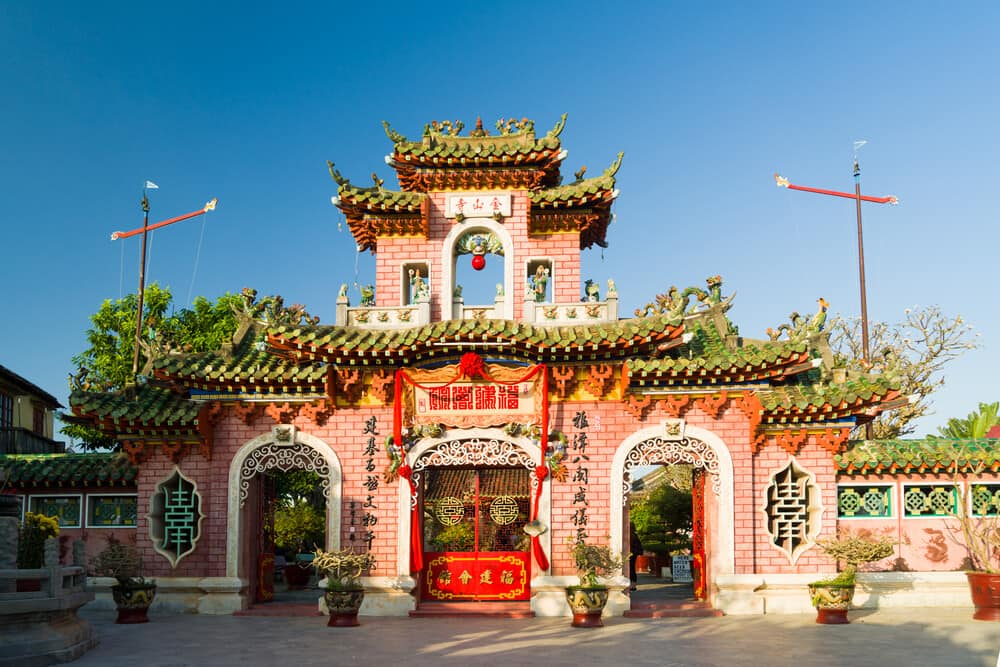
The vibrant red and orange hues of the triple gate at Fukien Assembly Hall instantly capture attention.
Passing through the gate, one enters a spacious courtyard that leads to the main hall, the most sacred area of the assembly hall. The interior is adorned with elaborately carved columns featuring dragons and phoenixes, gilded plaques, and large incense coils hanging from the ceiling, filling the air with a soothing aroma, creating a solemn and reverent atmosphere.
At the heart of the main hall is the altar dedicated to Thien Hau Holy Mother, the guardian deity of seafarers, holding a special significance in the religious beliefs of the Chinese community, past and present. Additionally, the assembly hall also enshrines other deities such as the God of Wealth, the Gods of Fortune, Longevity, and Happiness, as well as legendary figures from Chinese culture like the Sixian Ancestors. Beyond its religious functions, the assembly hall serves as a venue for traditional festivals and a gathering place for the Chinese community in Hoi An to connect and support each other.
Believed to be a sacred place where wishes come true, locals and visitors alike flock to the Fukien Assembly Hall to offer prayers and seek blessings. As a result, the hall is particularly bustling during full moon days, festivals, and special occasions like the Yuanxiao Festival (15th day of the first lunar month), the Sixian Ancestors’ Anniversary (16th day of the second lunar month), and the Thien Hau Festival (23rd day of the third lunar month). These occasions are marked by vibrant celebrations that draw both local and international tourists, offering a unique cultural experience to those visiting the assembly hall during these festive periods.
Therefore, visitors who come to the Fukien Assembly Hall on these special days will have the opportunity to immerse themselves in the local culture and discover the unique traditions of the people of Hoi An.
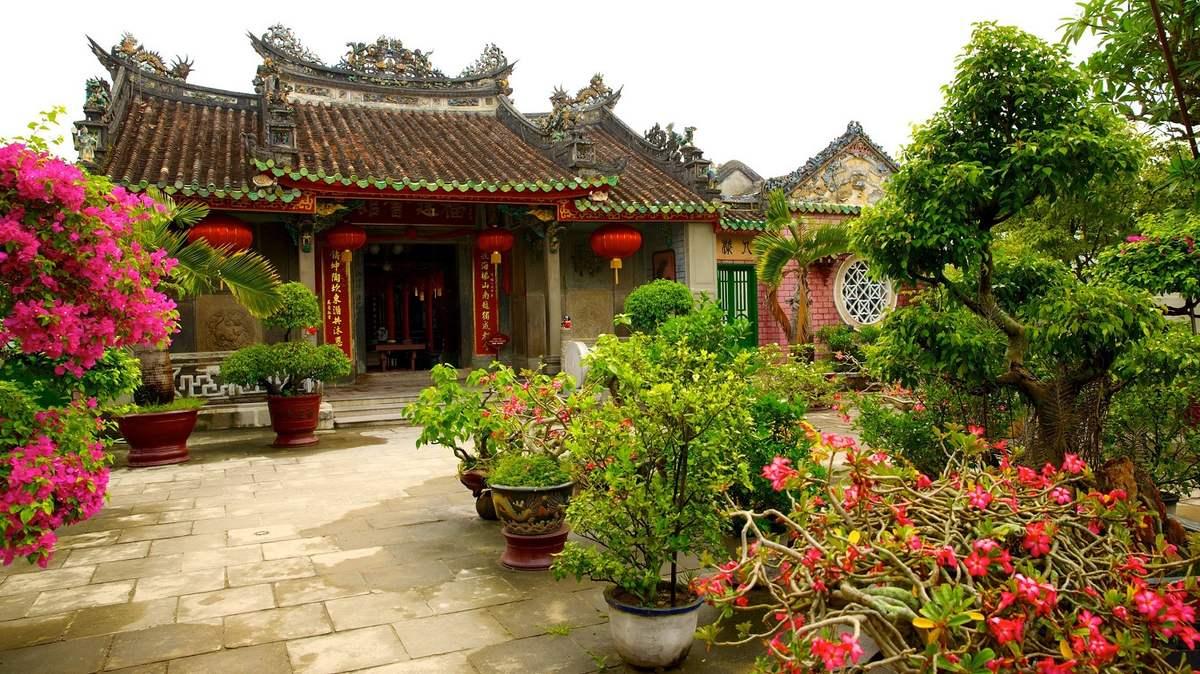
The Fukien Assembly Hall exudes a sense of tranquility with its subdued and ancient hues.
Unique Symbols and Details That Captivate Visitors
One of the distinctive features of the Fukien Assembly Hall is the subtle blend of architectural and sculptural elements, creating a space rich in symbolic meaning. From the coiled dragon on the roof to the carved image of a fish transforming into a dragon on the threshold, each element conveys wishes for prosperity, good fortune, and peace.
Standing prominently in the courtyard is a large bronze incense burner, intricately adorned with mythical creatures like the qilin and phoenix. Nearby, an ancient bronze bell, crafted in the 18th century, is carefully preserved and rung during major festivals, adding to the hall’s allure.

The interior of the Fukien Assembly Hall showcases the cultural influences of the Chinese community.
Of particular interest to many visitors are the large incense coils hanging high, a distinctive feature in Chinese assembly halls. Each coil represents the prayers and aspirations of the people, carrying hopes for health, wealth, and tranquility.
Beyond its architectural beauty, the Fukien Assembly Hall is an ideal destination for those seeking to delve into the history of Hoi An’s formation and the cultural integration between the Vietnamese and Chinese communities. The hall regularly hosts traditional festivals like the Thien Hau Festival and the Yuanxiao Festival, attracting locals and tourists alike.
For visitors, the Fukien Assembly Hall offers a unique experience – a serene space for contemplation and worship, as well as an intriguing site for exploration and capturing memorable photographs imbued with Eastern charm. For photography enthusiasts, every detail within the assembly hall, from the moss-covered tiles to the vibrant triple gate and the sunlight filtering through intricately carved wooden doors, presents a captivating backdrop.


Visitors pose for photographs in front of the Fukien Assembly Hall, capturing the essence of Eastern charm.
Located at 46 Tran Phu Street, one of the busiest and most ancient streets in Hoi An, the Fukien Assembly Hall is a must-visit destination for those exploring the ancient town. With its unique architecture reflecting strong Chinese influences and its spiritual ambiance, the hall offers a prominent “check-in” spot and provides insights into the history of the Fukienese community in Hoi An. Visitors can explore the assembly hall from early morning to late afternoon, between the hours of 07:00 and 17:00. Entrance fees range from 80,000 VND (for Vietnamese visitors) to 150,000 VND (for international visitors).
As a place of worship, it is important for visitors to dress modestly and behave respectfully to maintain the solemn atmosphere. Incense coils and other offerings are available for purchase within the temple, so there is no need to bring these items from outside.
A trip to Hoi An is truly incomplete without a visit to the Fukien Assembly Hall. It is not just a famous “check-in” spot but also a symbol of cultural diversity, hospitality, and the preservation of heritage in this ancient town.
A Romantic Escape: Diệp Lâm Anh and Her Beau’s Journey to Danang and Hoi An Amidst the Storm
Amidst the raging storm in Da Nang, Diep Lam Anh opted for a relaxing respite within the confines of a luxurious resort. With the tempestuous weather outside, she seized the opportunity to unwind and recharge, patiently biding her time until the storm subsided. Only then did she embark on her eagerly anticipated exploration of the enchanting ancient town of Hoi An.
The Scenic Route: A Mini ‘Hoi An’ in Dien Bien
The scenic route along the hydroelectric lake is a sight to behold. With swaying coconut trees lined up on one side and the traditional stilt houses of the White Thai people on the other, it paints a picturesque scene. This idyllic setting has captivated travelers, who liken it to a miniature version of the enchanting town of Hoi An.
The Ancient Temple of Hoi An: A Majestic Structure with a Unique Incense Offering
The Fukien Assembly Hall, a 300-year-old landmark in the ancient town of Hoi An (Quang Nam), is a testament to the rich historical and cultural heritage of the region. This exquisite structure, with its unique and distinctively Chinese architecture, has become a magnet for tourists from all over the world.

























